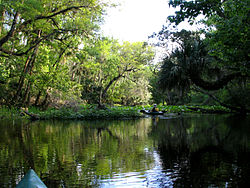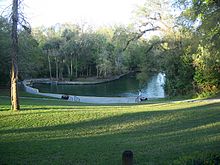Wekiva River
| Wekiva River Wekiwa | |
|---|---|
 Canoeing on the Wekiva River | |
| Location | |
| Country | United States |
| State | Florida |
| Counties | Orange, Lake, Seminole |
| Physical characteristics | |
| Source | Wekiwa Springs |
| • location | Apopka, Florida |
| • coordinates | 28°42′42.80″N 81°27′37.5″W / 28.7118889°N 81.460417°W |
| • elevation | 70 ft (21 m) |
| Source confluence | Wekiwa Springs Run and Rock Springs Run |
| • location | Apopka, Florida |
| • coordinates | 28°42′54.5″N 81°26′57.2″W / 28.715139°N 81.449222°W |
| Mouth | |
• location | DeBary, Florida |
• coordinates | 28°52′39.2″N 81°22′1.3″W / 28.877556°N 81.367028°W |
• elevation | 30 ft (9.1 m) |
| Length | 16.0 mi (25.7 km) |
| Basin size | 351.113 sq mi (909.38 km2) |
| Basin features | |
| River system | St. Johns River |
| Tributaries | |
| • left | Rock Springs Run, Mastodon/Wekiva Falls Run, Blackwater Creek |
| • right | Sweetwater Creek, Little Wekiva River |
| Elevation reference | [1] |
| Progression : Wekiva River-St. Johns River-Atlantic Ocean | |
| Type | Wild, Scenic, Recreational |
| Designated | October 13, 2000 |
The Wekiva River (sometimes spelled Wekiwa, a
Wekiwa is the
Overview
The Wekiva River system is located in three counties - Orange, Seminole, and then Lake - with a total drainage basin of 351.113 km2 (135.565 sq mi).[9] The Wekiva River nearly follows the boundary between Orange and Seminole Counties. After Orange County, the river separates Lake County and Seminole County.[10]
Origin

According to the St. Johns River Water Management District and the Geographic Names Information System, the Wekiva River originates from Wekiwa Springs, and about 3⁄4 mile (1.2 km) from the spring, Wekiva is joined by the Rock Springs Run.[3][11]
The Florida Department of Environmental Protection defines the portion of the river from Wekiwa Springs to the confluence with Rock Springs Run as the Wekiwa Springs Run. The Wekiva River then starts from the
Course
Wekiwa Springs
The
Rock Springs Run
After only about 3⁄4 mile (1.2 km) from the headwater, the Wekiva River is joined by Rock Springs Run, a spring-fed

Bridge to nowhere
A bridge to nowhere spans the river before the Wekiva Island marina about 520 yards (480 m) from the confluence with Rock Springs, the first of the two bridges that spans the river. The bridge is located at the end of Miami Springs Drive in Seminole County.
Sweetwater Creek
The Wekiva is joined by Seminole County's Sweetwater Creek about 1.2 mi (1.9 km) from the headwater. The 2-mile (3.2 km)-long stream is merged by the outflow of Miami Springs, a third- magnitude spring, about 800 ft (240 m) before the confluence with Wekiva River.[17]
Wekiva River Buffer Conservation Area
Beyond the creek, the eastern side of the river is protected by the Wekiva River Buffer Conservation Area, a 2,570 acres (1,040 ha) protected seasonal
Little Wekiva River
The Little Wekiva River merges with the Wekiva River about 4.7 mi (7.6 km) from the source. The 15-mile (24 km)-long Little Wekiva River is the only tributary influenced by the areas north and west of urban
River Bridges
The State Road 46 and State Road 429 tri-spans are the only active roads that span the river with the bridges about 9 miles (14 km) from the Wekiwa Springs State Park.
Black Water Creek
The last main tributary of the Wekiva River is the 19-mile (31 km) Blackwater Creek, which joins the Wekiva about 2 miles (3.2 km) before the Wekiva joins the St. Johns River.
See also
- List of Florida rivers
References
- ^ "Wekiwa Springs State Park Topo Map". Trails.com. Retrieved on 2012-11-26.
- ^ Simpson, J. Clarence (1956). Mark F. Boyd (ed.). Florida Place-Names of Indian Derivation. Tallahassee, Florida: Florida Geological Survey.
- ^ a b "Wekiva River". St. Johns River Water Management District. Retrieved on 2013-04-02.
- ^ "Wekiva River Aquatic River Preserve". Florida Department of Environmental Protection. Retrieved on 2013-04-15.
- ^ "The Wekiva Wild & Scenic River". National Park Service. Retrieved on 2012-04-01.
- ^ Florida State Parks: Wekiwa Springs State Park: History and culture
- ^ Jim Toner, Orlando Sentinel, You Say 'Wekiva,' I Say 'Wekiwa', July 20, 1999
- ^ The Wekiwas and Wekivas of Orange County, Garner, Mary Kerns. 1983 December. Research sponsored by The Apopka Historical Society.
- ^ "02235000 (Wekiva River)". St. Johns River Water Management District. Retrieved on 2013-04-01.
- ^ DeLorme (1997). "Florida Atlas & Gazetteer", pg. 80. DeLorme (publisher), Yarmoth, ME.
- ^ "Feature Detail Report for: Wekiva River". Geographic Names Information System (GNIS). Retrieved on 2013-04-16.
- ^ "Description of Wekiva River Aquatic Preserve". Florida Department of Environmental Protection. Retrieved on 2013-04-03.
- ^ "Wekiwa Springs". St. Johns river Water Management District. Retrieved on 2012-04-02.
- ^ "Wekiwa pool". Google Maps. Retrieved on 2013-04-02.
- ^ Wekiwa Springs State Park map. Florida State Parks. Retrieved on 2013-04-02.
- ^ "Rock Springs". St. Johns River Water Management District. Retrieved on 2012-04-21.
- ^ "Little Wekiva River". Seminole County Water Atlas. Retrieved on 2013-04-02.
- ^ "Wekiva River Buffer Conservation Area". St. Johns river Water Management District. Retrieved on 2012-04-02.
- ^ "L76. Wekiva River Buffer Conservation Area / Sabal Point Sanctuary". Great Florida Birding Trail. Retrieved on 2013-04-16.
- ^ "Little Wekiva River". St. Johns River Water Management District. Retrieved on 2013-04-16.
- ^ "Seminole County Springs". St. Johns River Water Management District. Retrieved on 2013-04-16.


